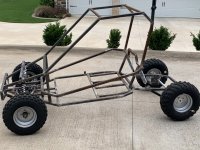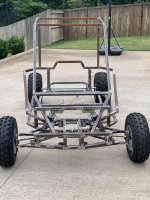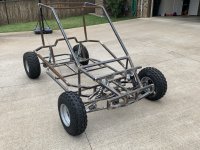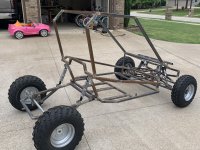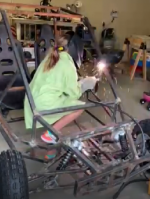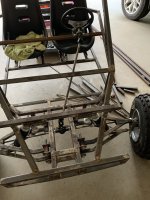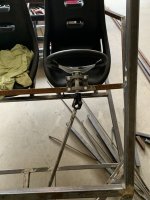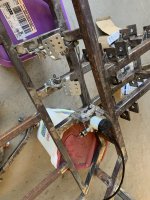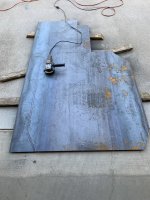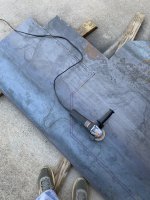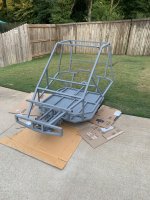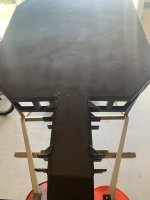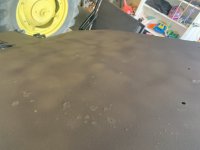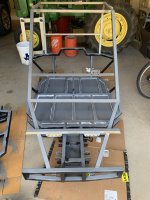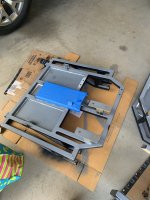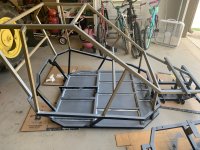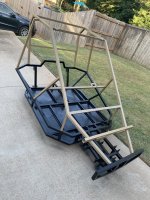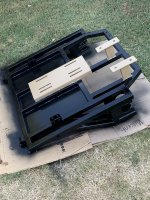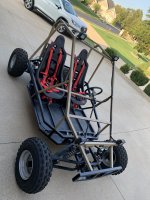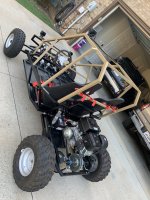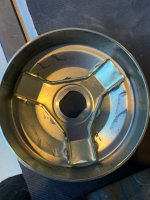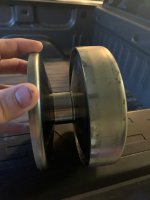I have been watching the DYGK forums for a while trying to learn as much as possible from all the different types of projects everyone has going. It has been very helpful.
We finally got the project up running on its own power about a month ago and have been tuning on bugs, so I'm finally ready to post. I'm not much of a social media person, but hope someone will find helpful tips scattered throughout.
My neighbors have joked that this has been autoshop for my daughters. They helped measure, mark, chop, grind, weld, sand, paint, bolt on most aspects.
Using the Arachnid plans, I stretched/widened both frames about 6" to accommodate adults. Also widened/heightened the front suspension box to account for the rack and pinion width to make eliminating bump steer easier, and have a better kingpin layout. Plan was to fit the two racing seats on sliders with a space between for parking brake. Wanted to use the Predator 420, so with that amount of power I felt like needed a little beefier suspension. That got us to widening the suspension and 20" tires.
Started with walking the girls through the plans to mark the extensions on frame drawings and then translate the marks to the pertinent parts cut sheets.
Rear frame was easiest to start fabrication. Funny how their personalities come out in using the tools. The type A older one barely pushes the chop saw hard enough throw sparks, the middle outgoing daughter bogs the saw down.
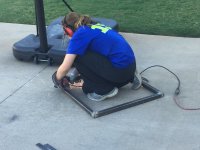
Built the back frame and only lower portion of main frame first. Wasn't convinced on layout of roll cage portion.
Then built a jig for the A-arms so they would be as close dimensionally as needed, and kept the jig in event a replacement is needed. The A-arm dimensions were enlarged a couple inches in length and spacing of attach points to handle the added loads.
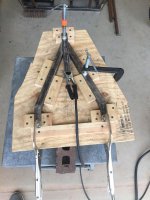
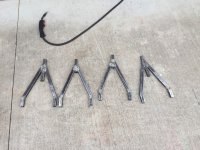
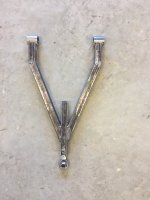
Where the heim joint attaches at the kingpin, I used a weld-in bung that has four plug welds and welded all around on the end. This is instead of the welded on nut in the plans.
One of the complications I added was not using the tractor links for the attach points. I felt these were inadequate for the setup, so I looked for a bushing layout and ended up recreating the wheel. I wanted to use 5/8 bolts. On the suspension block are welded tabs from 1/4" x 2" bar stock. On the A-arms is welded a piece of 2" pipe. We then poured polyurethane bushings. I looked at milling them from PU round bar stock, but it is difficult to mill.
If I were to do this again, I would not use the pipe and my own bushings. Great learn for the kids, and myself, but took way too long. These same items can be bought fairly inexpensively that thread into a welded bung.
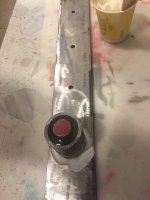
Front hubs are the typical trailer hubs, found a kit on sale that had axle, hub, and bearings for about $35 each kit. Vertical section is a piece of DOM, beveled at both ends, cut the hub axle to fit. I think the hub is about 5 degrees off perpendicular to the king pin. King pins are inclined about 8 degrees using the rake of the A-arm placement. Tie-rods are attached to a tab welded to the king ping just below the hub. Ended up with a 10" total travel without using the heim joint extenders.
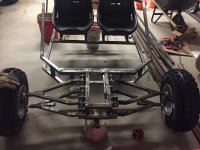
Will continue in second post.
We finally got the project up running on its own power about a month ago and have been tuning on bugs, so I'm finally ready to post. I'm not much of a social media person, but hope someone will find helpful tips scattered throughout.
My neighbors have joked that this has been autoshop for my daughters. They helped measure, mark, chop, grind, weld, sand, paint, bolt on most aspects.
Using the Arachnid plans, I stretched/widened both frames about 6" to accommodate adults. Also widened/heightened the front suspension box to account for the rack and pinion width to make eliminating bump steer easier, and have a better kingpin layout. Plan was to fit the two racing seats on sliders with a space between for parking brake. Wanted to use the Predator 420, so with that amount of power I felt like needed a little beefier suspension. That got us to widening the suspension and 20" tires.
Started with walking the girls through the plans to mark the extensions on frame drawings and then translate the marks to the pertinent parts cut sheets.
Rear frame was easiest to start fabrication. Funny how their personalities come out in using the tools. The type A older one barely pushes the chop saw hard enough throw sparks, the middle outgoing daughter bogs the saw down.

Built the back frame and only lower portion of main frame first. Wasn't convinced on layout of roll cage portion.
Then built a jig for the A-arms so they would be as close dimensionally as needed, and kept the jig in event a replacement is needed. The A-arm dimensions were enlarged a couple inches in length and spacing of attach points to handle the added loads.



Where the heim joint attaches at the kingpin, I used a weld-in bung that has four plug welds and welded all around on the end. This is instead of the welded on nut in the plans.
One of the complications I added was not using the tractor links for the attach points. I felt these were inadequate for the setup, so I looked for a bushing layout and ended up recreating the wheel. I wanted to use 5/8 bolts. On the suspension block are welded tabs from 1/4" x 2" bar stock. On the A-arms is welded a piece of 2" pipe. We then poured polyurethane bushings. I looked at milling them from PU round bar stock, but it is difficult to mill.
If I were to do this again, I would not use the pipe and my own bushings. Great learn for the kids, and myself, but took way too long. These same items can be bought fairly inexpensively that thread into a welded bung.

Front hubs are the typical trailer hubs, found a kit on sale that had axle, hub, and bearings for about $35 each kit. Vertical section is a piece of DOM, beveled at both ends, cut the hub axle to fit. I think the hub is about 5 degrees off perpendicular to the king pin. King pins are inclined about 8 degrees using the rake of the A-arm placement. Tie-rods are attached to a tab welded to the king ping just below the hub. Ended up with a 10" total travel without using the heim joint extenders.

Will continue in second post.

